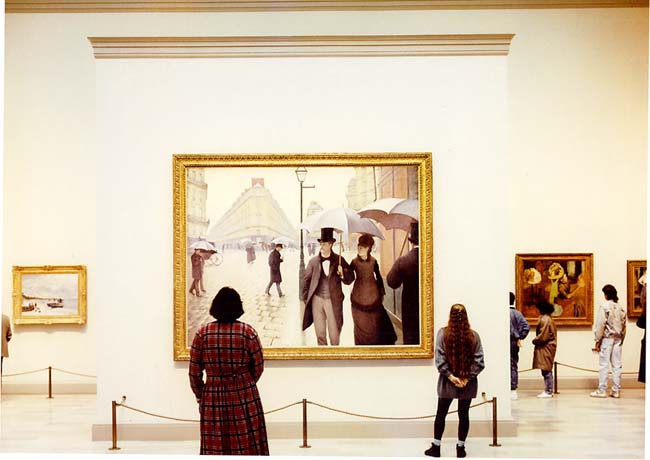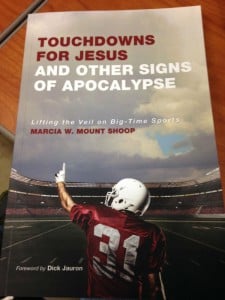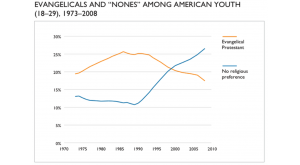What do looking at paintings have to do with what most evangelicals understand by “engaging,” “transforming,” and “redeeming” culture?
Not much.
It is no secret that North American evangelicals regard politics to be the primary means by which God is active in the world. And many evangelicals have recently become convinced that “culture” (i.e., films, television—media with large audience constituencies like YouTube) is an important means by which electoral politics can be affected and public policy shaped. This view, that the arts are simply “images” that shape desire is based on the classical Greek assumption that virtuous action requires virtuous images to contemplate. Change the images that speak to the heart and you can change behavior.
Yet no evangelical would follow Aristotle and the classical tradition and claim the polis to be of ultimate value, or conclude, as did the tutor of Alexander the Great, that if “ethics” is the diagnosis of the soul, then “politics” is its cure. It is Christ and his gospel that is the cure. It is not the City of Man, as St. Augustine called it, but the City of God, to which we look.
However, most evangelicals would agree, if not in word then in deed, that politics is the primary means by which we are called to bear witness to Christ in the world. If Christ is ultimate, then politics is “ultimately” penultimate. It is the standard against which all practices are evaluated and to which all forms of culture making must aspire to be a truly relevant Christian presence in the public sphere, either by connecting it to electoral politics or public policy, which are believed to secure and shape virtue.
The dominance of politics as the ultimately penultimate among evangelicals means that other cultural practices struggle for relevancy and support. It is presumed that theologies of culture and a robust Christian cultural presence must lead to or incorporate politics or policy. Paintings must lead to commentary on political action, poems to reflection on policy.
What is lost is the aesthetic integrity of a painting qua painting, poem qua poem, film qua film. Art’s relevance and usefulness is thus determined by how smooth the transition can be to a discussion of politics, public policy, and the public good—the issues that really matter.
But the gospel goes further than simply destroying the ultimacy of politics. It destroys all the penultimates—all those “secondary” practices and beliefs, professions and institutions, that we piously claim “protect” the gospel or preserve the freedom and virtue necessary for Christ to be heard. The gospel levels all vocations, all institutional structures.
Luther’s rediscovery of justification by faith meant a radical reconceptualization of vocation. If our work in the world—our good works—doesn’t go up to God, where does it go? Luther concluded that it goes out to our neighbor. And if none of our good works go up to God, then there are no vocations—including the “religious” vocations like priests and monks—which are superior to others.
From the priest to the shoe maker, the prince to the baker, all vocations, claimed Luther, were means by which God was busy at work in the world. If, as Luther argued, our vocations are not primarily about our self-fulfillment and justifying ourselves before God, but are expressions of our love for our neighbor, then it is not merely through political and policy work or through church work that God is present. He but he is active even in the most humblest endeavors, like waiting tables, and the most opaque of practices, like looking at paintings.
The gospel cuts the cables that we attach to God, those cables that we claim are only penultimate, but are in reality ways to prioritize how we think God should be active in the world. The gospel renders all work, all vocations, all institutions equally penultimate. It returns our endeavors to each and every one of us, liberating us from the burden of being relevant, from making shoes and mid-level management to making paintings and serving in public office.
And that is liberating not only to me, who feels called to write about paintings as a theologian of culture, but to you as well, who probably feel the same pressure that I do—the pressure to be a faithful Christian witness. The gospel also frees me to not justify my particular work by exaggerating its importance, by claiming that looking at a Cézanne painting, watching a Tarkovsky film, listening to Arvo Pärt, or reading a Mandelstam poem is somehow more important or more useful to God than looking at a Kinkade print, watching Star Wars, listening to Maroon 5, or reading Work, Love, Pray.
Called to do what I’m already doing, the gospel frees me to trust that God is busy at work in and through it, even if I can’t seem to figure out how or am able to convince others.
Let’s face it, God is busy at work in the living rooms of a married couple watching the new season of Mad Men on Sunday night just as he is in movie theaters and art museums, poetry readings, concert venues—just as he is in the voting booth, in Supreme Court, in Congress.
Through his Word, God’s work is already connected to my work and to yours—I don’t have to try to connect it because God has already done all the hard work.
All we need to do is respond, vocationally, in faith.












